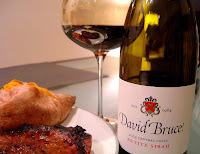 Name: Menuts
Name: Menuts Producer: Pierre Riviere
Region: France, Bordeaux, Libournais, St. Émilion
Region: France, Bordeaux, Libournais, St. Émilion
Classification: N/A
Type: Red Wine
Variety: Merlot 75%, Cabernet Sauvignon 15%, Cabernet Franc 10%
Year/Vintage: 2003
Bottle Size: 750ml
Purchased: $16.99, Specialty Wine Store
Date Logged: 04/30/2008
Pairing(s): Peppers stuffed with ground meat with tomato sauce
My Rating: 4.5 Stars
This wine qualified as delicious, and was one of the better wines we’ve had in awhile. Classic Bordeaux on the nose, with nice cedar and forest aromas up front and subtle red meat and cherry tones in the background. Likewise on the palate, with a soft but noticeable tannic finish. Very well balanced and enjoyable, it paired quite well with the stuffed peppers.
This wine qualified as delicious, and was one of the better wines we’ve had in awhile. Classic Bordeaux on the nose, with nice cedar and forest aromas up front and subtle red meat and cherry tones in the background. Likewise on the palate, with a soft but noticeable tannic finish. Very well balanced and enjoyable, it paired quite well with the stuffed peppers.
I bought this at a specialty store for $16.99, but I recently saw it in a grocery store in Virginia for around 12 bucks. Either way, this elegant wine is a great value and one that I will be looking to buy again.










